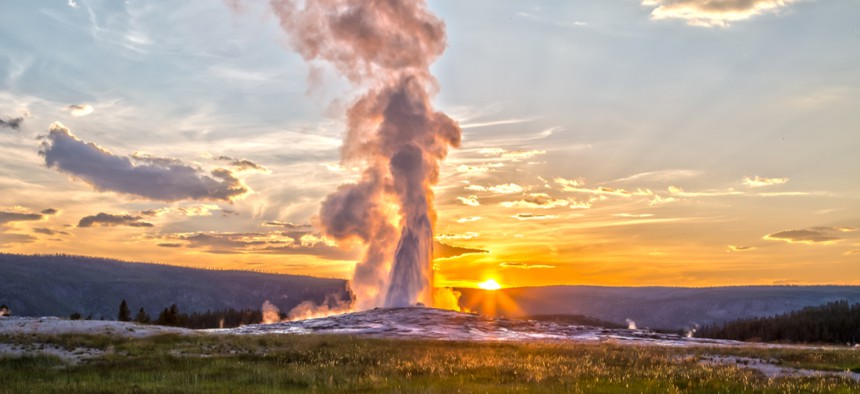Self-Driving Shuttles Are Set to Be Deployed at Yellowstone National Park in 2021

Susanne Pommer/Shutterstock.com
The National Park Service is exploring emerging, autonomous technologies through a new pilot program that the public can opt to participate in.
Two autonomous shuttles are set to be deployed in Yellowstone National Park next year, via an emerging mobility-focused pilot program the National Park Service is leading to explore the technology’s potential impacts on visitors’ experiences—and to prepare itself for the not-so-distant driverless future.
Florida-based autonomous mobility-as-a-service provider Beep, Inc. was tapped to plan, release and operate the park’s first-ever self-moving shuttles, which will roll around its Canyon Village area from late May through August 2021.
During that period, people in the park can catch a ride on those autonomous chauffeurs.
“The pilot is open to the public,” National Park Service Public Affairs Specialist Vanessa Lacayo confirmed to Nextgov over email Friday. And in a previous conversation Thursday, she said NPS is primarily interested in “better understanding how automated vehicle shuttle technologies can be used in parks and how visitors will perceive and engage these services,” through the initiative.
As a whole, the federal agency is proactively looking for ways to test, pilot and engage with innovative and evolving transportation technologies, and really gain a strong grasp of what all they have to offer.
With more than 4 million visits in 2019, Yellowstone was the sixth-most toured national park in America last year, Lacayo said, and due to its “unique natural environment and popularity,” NPS selected it to “gather especially useful information to advance [its] goals related to emerging mobility and better plan for the future of transportation.” The federal agency released a request for proposals to underpin the work in June and Beep was chosen in September, after a virtual industry day and 45-day window for vendor responses.
“They met all the requirements we were looking for and we are excited to be working with them on this project,” Lacayo said.
The company, according to a press release published this week, transported more than 16,000 passengers since its launch in September 2019, and touts what it calls the “the largest and longest running single site AV shuttle fleet” in the U.S.
The pilot is one piece of a range of federal initiatives intended to drive forward the government’s grip on autonomous vehicles. Its exact price-tag remains unclear, but Lacayo noted that through the Federal Lands Transportation Program—which was created to advance transportation infrastructure owned by certain federal lands management agencies—the National Park Service has been working directly with the Federal Highway Administration to introduce transportation improvements across the nation. The highway-focused agency recently produced innovation and research opportunities to fund projects within federal lands, like Yellowstone, up to $600,000.
“Part of that funding will be used for this project to support the contract and to support technical aspects needed on the project from start to finish,” Lacayo said.
Alongside Yellowstone, Beep will also work with the NPS Park Planning, Facilities and Lands Directorate and Transportation Department through the effort, which is one component of the broader Yellowstone Visitor Use Management Program. The low-speed, multi-passenger automated shuttles to be tested in Canyon Village could potentially serve the campground, visitor services, and adjoining visitor lodging areas—though the exact stops, route locations and distances will be puzzled out jointly by NPS and Beep a little further down the line. The hope is that the eco-friendly, electric vehicles may even help relieve some congestion in the park.
Lacayo said data from the pilot will also help guide how the agency moves forward long-term and prepares for future changes across the transportation industry.
“We are particularly interested in looking at how these shuttles impact visitor experiences, mobility and safety,” she noted. “Once we have a better understanding of that, we can think about what the future holds for projects like these.”
And Lacayo made it a point to emphasize that throughout the duration of the pilot, “visitor and employee safety is paramount.” Every move will be monitored by an onboard shuttle specialist, on the ground staff and Beep’s Global Command Center. And before any work kicks off, the company will have to prove it has insurance for operating the mobile vehicles in the state of Wyoming, which will also be required at all times throughout the contract’s lifespan. Beep must also produce a safety and risk mitigation plan and undergo several weeks of onsite testing ahead of the full, official launch. The business is further expected to regularly report all data tied to ridership, departure times, route performance and battery performance to NPS.
“Similarly, they are required to report any crashes or near crashes immediately to our law enforcement officers,” Lacayo said.






